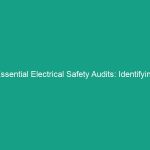Introduction
In the realm of Health, Safety, and Environment (HSE), the significance of Workplace Safety cannot be overstated. Organizations are increasingly aware that a safe work environment not only protects their employees but also enhances productivity and reduces costs associated with workplace accidents. One of the critical Hazards that many workers face is the risk of an arc flash. This article aims to provide a comprehensive understanding of arc flash and its Prevention techniques, emphasizing the importance of proactive Safety Measures in the workplace.
Arc flashes are sudden, explosive releases of energy caused by electrical faults, and they can lead to severe injuries or fatalities. Understanding arc flash and its prevention techniques is essential for Safety professionals, electrical engineers, and anyone working with or around electrical equipment. This guide will delve into the various aspects of arc flash, including regulatory frameworks, best practices for prevention, real-world case studies, and future trends in Safety Measures.
Understanding Arc Flash
What is an Arc Flash?
An arc flash occurs when an electric current passes through the air between ungrounded conductors or between a conductor and the ground. This phenomenon generates intense heat, light, and pressure, resulting in potentially catastrophic consequences. The temperatures can exceed 35,000 degrees Fahrenheit, causing severe Burns, fires, and even explosions. The force of an arc flash can also propel molten metal and shrapnel, posing additional risks to nearby personnel.
Causes of Arc Flash
Understanding the causes of arc flash is crucial for developing effective prevention strategies. Some common causes include:
- Equipment Failure: Malfunctioning electrical components can lead to faults that trigger an arc flash.
- Improper Maintenance: Neglecting regular maintenance can result in worn or damaged equipment, increasing the likelihood of an incident.
- Human Error: Mistakes made during Operation or maintenance can create conditions conducive to arc flash incidents.
- Environmental Factors: Dust, moisture, and corrosion can compromise electrical equipment and contribute to failures.
Statistics and Impact
The statistics surrounding arc flash incidents are alarming. According to the National Fire Protection Association (NFPA), there are approximately 30,000 arc flash incidents reported annually in the United States alone. These incidents can result in significant property damage and lead to injuries or fatalities. In many cases, arc flash events are preventable through proper Training, equipment maintenance, and adherence to Safety protocols.
Regulatory Frameworks and Standards
Understanding Regulatory Requirements
Various Regulations and standards govern Electrical Safety and arc flash prevention. Organizations must comply with these guidelines to ensure a safe working environment. Key regulations include:
- Occupational Safety and Health Administration (OSHA): osha establishes safety standards for workers, including electrical safety regulations that address arc flash Hazards.
- National Fire Protection Association (NFPA) 70E: This standard focuses on electrical safety in the workplace, providing guidelines for mitigating arc flash risks.
- Institute of Electrical and Electronics Engineers (IEEE) 1584: This standard outlines the methods for calculating arc flash hazards and determining appropriate safety measures.
Importance of Compliance
Compliance with these regulations is not merely a legal obligation; it is a critical component of a robust safety culture. Organizations that prioritize compliance demonstrate their commitment to employee safety and risk management. Additionally, adhering to these guidelines can significantly reduce the likelihood of accidents and their associated costs. Regular audits and assessments of compliance can help organizations identify gaps and implement necessary improvements.
Best Practices for Arc Flash Prevention
Conducting Arc Flash Hazard Analysis
One of the first steps in understanding arc flash and its prevention is conducting a thorough arc flash hazard analysis. This process involves evaluating the electrical system to identify potential arc flash risks. Key steps include:
- Data Collection: Gather information about the electrical system, including equipment specifications, configurations, and operating conditions.
- Short-Circuit Analysis: Perform a short-circuit analysis to determine the available fault current at various locations within the system.
- Arc Flash Calculations: Use the data collected to calculate the incident energy levels and determine the appropriate Personal Protective Equipment (PPE) required.
- Labeling: Clearly label electrical equipment with arc flash warning labels that indicate the potential hazards and required PPE.
Implementing Electrical Safety Programs
Developing and implementing a comprehensive electrical safety program is essential for preventing arc flash incidents. This program should include:
- Training and Education: Provide regular training for employees on electrical safety, including recognizing hazards, proper use of PPE, and safe work practices.
- Safe Work Practices: Establish and enforce safe work practices, such as lockout/tagout Procedures and proper maintenance protocols.
- Emergency Response Plans: Develop and communicate emergency response plans to ensure employees know how to react in the event of an arc flash incident.
Utilizing Personal Protective Equipment (PPE)
Personal protective equipment plays a crucial role in safeguarding employees from arc flash hazards. Selecting the right PPE is vital for ensuring safety. The selection process should include:
- Arc Rating: Choose PPE with an appropriate arc rating that corresponds to the calculated incident energy level.
- Layering: Use layered clothing systems to provide additional protection while ensuring comfort and mobility.
- Regular Inspections: Conduct regular inspections and maintenance of PPE to ensure its effectiveness and longevity.
Case Studies: Lessons Learned from Arc Flash Incidents
Case Study 1: The Importance of Training
In one notable incident, a technician suffered severe burns during a routine maintenance task on electrical equipment. The investigation revealed that the technician had not received adequate training on arc flash hazards and the necessary safety Precautions. This incident underscores the critical importance of comprehensive training programs in preventing arc flash incidents. Organizations must prioritize ongoing education and ensure that all personnel are equipped with the knowledge and skills to work safely around electrical systems.
Case Study 2: Effective Use of PPE
Another incident involved a worker who experienced an arc flash while performing maintenance on a circuit breaker. Fortunately, the worker was wearing appropriate PPE that had an adequate arc rating. While the worker sustained minor injuries, the use of proper PPE prevented more severe consequences. This case highlights the importance of not only selecting the right PPE but also ensuring that it is consistently used and maintained. Organizations should enforce PPE policies and conduct regular training to reinforce the importance of wearing protective gear.
Case Study 3: Comprehensive Hazard Analysis
A manufacturing facility conducted a thorough arc flash hazard analysis and implemented recommended safety measures. As a result, they significantly reduced their incident rates and improved overall safety culture. This case demonstrates the effectiveness of proactive safety measures, including hazard analysis, labeling, and employee training. Organizations that take the initiative to understand arc flash risks and implement preventive strategies can create a safer work environment for all employees.
Challenges in Arc Flash Prevention
Complexity of Electrical Systems
One of the primary challenges in understanding arc flash and its prevention is the complexity of modern electrical systems. As technology continues to evolve, electrical systems become more intricate, making it difficult to identify potential hazards. Organizations must invest in advanced tools and expertise to conduct thorough analyses and stay ahead of emerging risks.
Employee Compliance and Culture
Another significant challenge is fostering a culture of safety among employees. Despite the best safety protocols, if employees do not adhere to safety measures or fail to recognize hazards, the risk of arc flash incidents remains high. Organizations must focus on building a safety culture that encourages open communication, accountability, and continuous improvement.
Keeping Up with Regulatory Changes
Regulatory frameworks related to electrical safety are constantly evolving. Staying compliant with these changes can be challenging for organizations, particularly smaller businesses with limited resources. Regular training and updates on regulatory requirements are essential to ensure that organizations remain compliant and maintain a safe working environment.
Future Trends in Arc Flash Safety
Advancements in Technology
As technology progresses, new tools and solutions are emerging to enhance arc flash safety. Smart sensors and monitoring systems can provide real-time data on electrical systems, enabling organizations to identify potential hazards before they escalate. Additionally, augmented reality (AR) and virtual reality (VR) training programs are being developed to provide immersive training experiences for employees, improving their understanding of arc flash risks and safety measures.
Increasing Focus on Mental Safety
In the future, organizations are expected to place a greater emphasis on the mental well-being of employees in relation to safety. Understanding that stress and fatigue can impact decision-making and safety compliance is crucial for creating a holistic safety program. Integrating mental health support into safety initiatives can foster a more resilient workforce capable of effectively responding to potential hazards.
Regulatory Evolution
Regulatory bodies will continue to refine and update electrical safety standards to address emerging risks. Organizations must stay informed about these changes and proactively adapt their safety programs to maintain compliance. Engaging with industry associations and participating in safety forums can help organizations stay ahead of regulatory trends and Best Practices.
Conclusion
Understanding arc flash and its prevention techniques is paramount for ensuring Workplace Safety in environments where electrical systems are present. By conducting thorough hazard analyses, implementing robust safety programs, and prioritizing employee training, organizations can significantly reduce the risks associated with arc flash incidents. The statistics surrounding arc flashes underscore the urgent need for proactive measures to protect workers and create a culture of safety.
As we move forward, it is essential to embrace technological advancements and foster a comprehensive understanding of safety regulations. By doing so, organizations can create safer work environments and ultimately save lives. We encourage all readers to take action by reviewing their current safety practices, investing in training, and prioritizing compliance with safety standards. Together, we can work towards a safer future for everyone.


